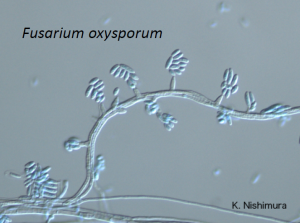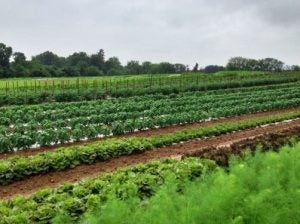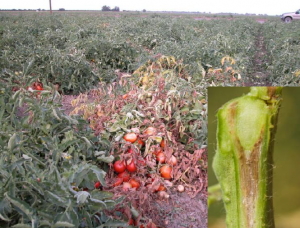Fusarium oxysporum f. sp lycopersici race 3, the cause of Fusarium wilt in tomato
 With recent spread of the new Fusarium wilt race, Fusarium oxysporum f. sp. lycopersici (Fol) race 3, all major processing tomato regions in California are suffering severe losses. Factors influencing build up and persistence of Fol race 3 in California are poorly understood; alternate hosts are not known, the potential for cryptic colonization of resistant hosts has not been examined, and effects of environment on persistence are not well characterized. Practices are needed which discourage inoculum accumulation and persistence at high levels, reducing the chances of a new resistance-breaking race emerging in the state. We are initiating several concurrent research lines to address these issues.
With recent spread of the new Fusarium wilt race, Fusarium oxysporum f. sp. lycopersici (Fol) race 3, all major processing tomato regions in California are suffering severe losses. Factors influencing build up and persistence of Fol race 3 in California are poorly understood; alternate hosts are not known, the potential for cryptic colonization of resistant hosts has not been examined, and effects of environment on persistence are not well characterized. Practices are needed which discourage inoculum accumulation and persistence at high levels, reducing the chances of a new resistance-breaking race emerging in the state. We are initiating several concurrent research lines to address these issues.
Research questions:
Are all rotation crops created equal? The relative impact of rotation cropping vs. extended fallow in managing persistence of Fol in infested soils.
 It is common practice for processing and fresh tomato producers to rotate tomato and non-tomato crops in an effort to manage Fusarium wilt. In result, a large suite of vegetable, grain and cover crops are grown in fields that harbor Fusarium oxysporum f. sp. lycopersici (Fol).
It is common practice for processing and fresh tomato producers to rotate tomato and non-tomato crops in an effort to manage Fusarium wilt. In result, a large suite of vegetable, grain and cover crops are grown in fields that harbor Fusarium oxysporum f. sp. lycopersici (Fol).
We are interested in determining whether alternate crops can allow inoculum loads to persist for longer periods compared to an extended fallow, whether all crops are equally conducive to inoculum persistence, and the period of time Fusarium wilt can survive in soil on infested tomato tissue. Based on this, we can provide both processing and fresh market producers with more precise recommendations for soil management strategies to suppress persistence of Fol.
Understanding effects of stress on fusarium wilt resistance and resistance breaking race monitoring program
 The I3 gene conveys resistance to Fusarium wilt race 3 and has been successfully integrated into commercial cultivars. Recent release of resistant (F3) cultivars has resulted in widespread use of resistant cultivars, and associated challenges.
The I3 gene conveys resistance to Fusarium wilt race 3 and has been successfully integrated into commercial cultivars. Recent release of resistant (F3) cultivars has resulted in widespread use of resistant cultivars, and associated challenges.
Field stability of genetic resistance. One challenge in use of F3 lines is apparent break down under stress, resulting in Fusarium wilt development in resistant lines. We are looking at the soil traits associated with Fusarium wilt development and characterizing the effects of abiotic stresses such as soil salinity on I3 gene stability.
Monitoring for a new resistance breaking race 4. California has seen the emergence of three successive races and emergence of a new race 4 is perhaps the single largest fear of the industry. As F3 cultivars become more widely used there is both the chance of detecting a pre-existing resistance-breaking race 4 and/or creating selection pressure for race 4 emergence. We are the state testing lab for Fusarium wilt race 4 monitoring and annually test 10-20 possible race 4 isolates. To date, Fusarium wilt race 4 of tomato has not been found.